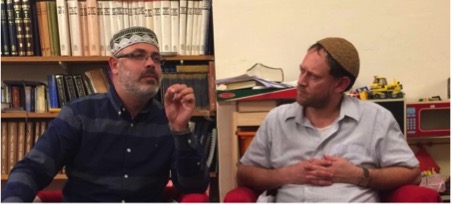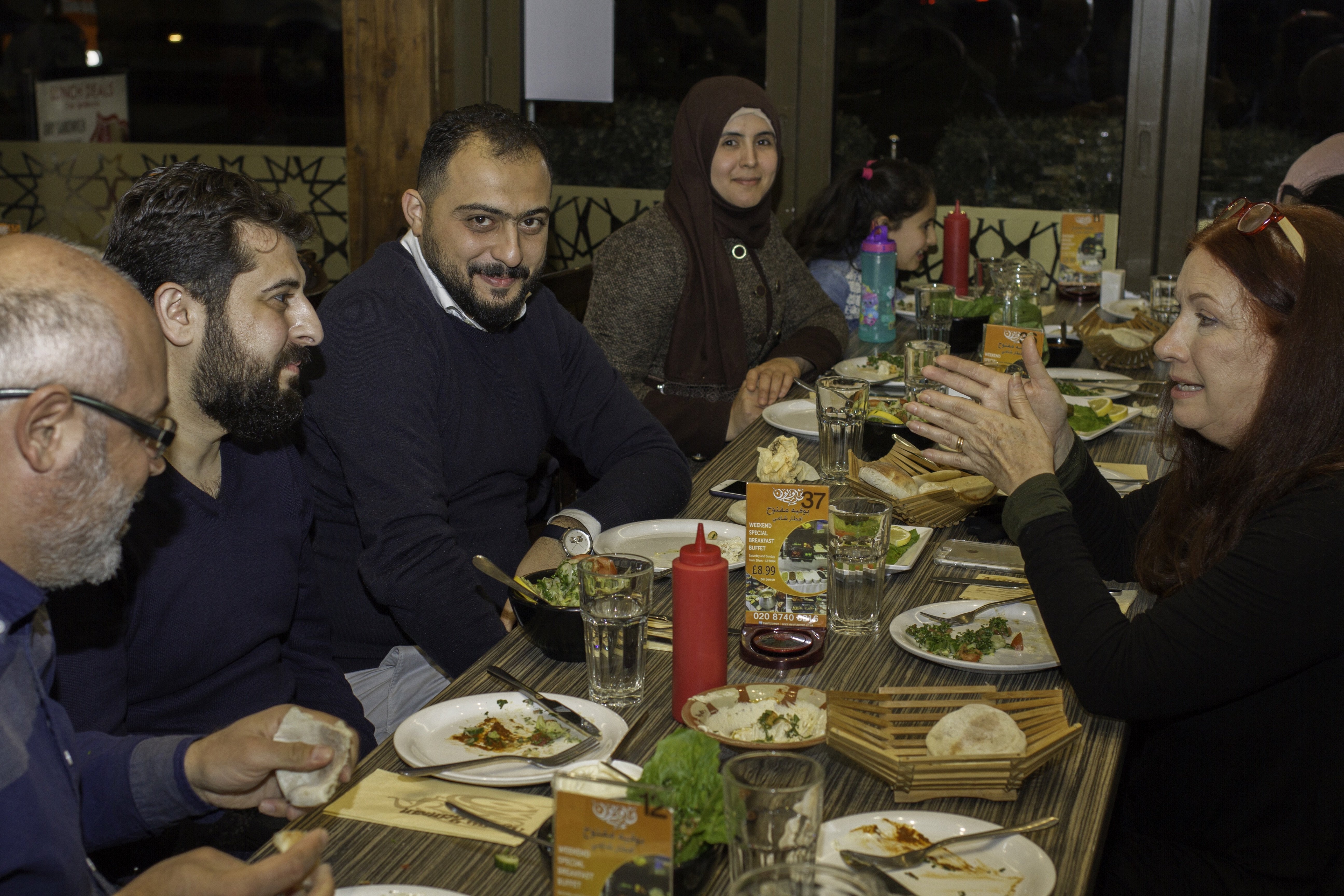UK Speaking Tour, November 2017

Sheikh Ghassan Manasra and Rev. Cherag Anna Less Phd travel to London and the UK for a late-autumn speaking tour which also includes National Interfaith Week in the UK. They are joined by Sheikh Ghassan’s daughter and AR young adult leader Zeynab Manasra, Rabbi Mordechai Zeller (trustee to AR UK and Rabbi in residence at Cambridge University), and Michael & Amanda Kenton, co-founders of AR UK.
The Zohar, Interreligious Text Study at Cambridge University with Rabbi Mordechai Zeller, and Ibn Arabi
Today we traveled to Cambridge to meet with Abrahamic Reunion Peacemaker Rabbi Mordechai Zellar who is currently the Jewish Chaplain at Cambridge University. It is interfaith week in England, and Mordechai has invited the Abrahamic Reunion, and the Cambridge University Islamic Society (ISOC) to his weekly Zohar study group.
The word Zohar means “splendor” or “radiance” and it is considered to be the core text of Jewish mystical thought known as Kabbalah, which offers a mystical interpretation of the Bible.
Composed by kabbalist Rav Shimon bar Yochai, the Zohar is a set of twenty-three books that provide a commentary on biblical and spiritual matters in the form of conversations among spiritual masters. On the one hand it is a vast, comprehensive commentary on biblical matters, and on the other hand it is intended to be a guidebook for the lost divine nature of our souls, and the Zohar describes all of the spiritual states that the sole experiences as it evolves. At the end of this process, the soul achieves what Kabbalah refers to as “the end of correction,” the highest level of spiritual wholeness.
Often written as a cipher, the codes, metaphors, and cryptic language of the Zohar are designed to provide channels for spiritual energy.
Hidden for 900 years between the 2nd and 11th centuries, the Zohar began to be shared in the 16th century when The Holy Ari, Rabbi Isaac Luria (1534-1572) stated that from his time onward, the wisdom of Kabbalah was ready to be opened to everyone.
The topic of today’s interfaith study group will be the relationship between Abraham and his nephew Lot from the perspective of Judaism, and Islam.
Mordechai, Ghassan and I have had a few conference calls to prepare for this evening. When Ghassan mentions to Mordechai that he would like to use Ibn Arabi’s book “The Bezels of Wisdom” as his source for speaking about Abraham, Mordechai not only runs out to get Ghassan a current copy of the book from the store, he makes arrangements for us to visit Cambridge University’s research library to study some of the earliest known copies of this precious book.
Called by Muslims “the greatest master,” Ibn Arabi was a Sufi born in twelfth-century Spain. At the end of his life, while in Damascus Ibn Arabi had a vision that prompted him to write this book. He describes the experience in his preface.
“I saw the Apostle of God in a visitation…He had in his hand a book, and he said to me, “This is the book, “The Bezels of Wisdom”, take it and bring it to men that they might benefit from it.”
A “Bezel” is a setting on a ring, and in Arab culture this “Bezel” would have been set with a gem and engraved with the wearer’s name, to make the ring into a seal.
The “setting” that holds Ibn Arabi’s gem of spiritual wisdom, describes the author’s mystical insights through the lives of each of the prophets, and Ghassan wants to share with our group Ibn Arabi’s esoteric commentaries on the life of Abraham.
As we walk on cobblestone streets, through Cambridge’s medieval neighborhoods, we feel as though we have already begun a journey back in time.
Outside the Cambridge Library Itai Kagen, the son of Rabbi Ruth Kagen and Michael Kagan, who have participated in many Abrahamic Reunion events in Israel, comes running up to us to embrace Ghassan. Visiting from Hebrew University, Itai is living in London to do Biblical research. He has heard that Ghassan will be teaching with Mordechai in Cambridge, and has traveled with his wife 2 hours by train to attend Mordechai’s Zohar class so he can hear Mordechai and Ghassan teach together. While we use the library’s research room to study Ibn Al’ Arabi, he will be here to study an ancient Hebrew manuscript found in Egypt.
We enter the library bearing 2 forms of ID. Security is tighter here than at the prison we had entered together two days earlier.
We are escorted through a series of locked doors that require pass codes, to a room containing Cambridge University’s most valuable and precious books. Photos are forbidden as two ancient volumes are offered to us on pillows. Only one person, Estara, the research specialist has permission to touch the books, and turn the pages, which have been mounted on special paper to preserve them. One book was composed in the 14 century, and the other one was written in the 16 century. Several different scribes hand wrote each volume, as Estara points out where the script of each different scribe changes. We hover around Estara, as she turns the pages, and Ghassan begins to read out loud when he comes to the section on Abraham. Certain pages contain blank symbols in the midst of the hand written script. Ghassan explains these esoteric symbols are ciphers and amulets used to transmit realization and messages to the reader. The margins of the pages contain hand written notes in Arabic, Hebrew, and other ancient languages, the work of long ago scholars deciphering the esoteric contents for their own research.
Ghassan reads aloud to us and translates as he goes along. The whole experience has a mystical quality so different than reading on the Internet, or from a modern mass-produced book. And we are mesmerized by the experience.
We also take time to visit Itai at the table behind us, as he carefully sifts through the fragments of an ancient Hebrew manuscript that have been suspended between large sheets of plastic. He and Mordechai and Ghassan read it together and Itai explains that he can speak at least eleven ancient biblical languages, and he is here to do research for his professors at Hebrew University. He says he and Estara will meet us later at Mordchai’s Zohar class.
As we gather for our meeting about 25 people enter the room. As they introduce themselves I am quick to realize that this text study group is not going to be like any text study group I have attended before. This will be a meeting of biblical scholars. Although many are still students most are postgraduates doing advanced biblical study.
Mordechai begins by telling the story of Abraham and Lot’s relationship, in a historical context, then Mordechai begins to use the Zohar to peel back the outer layers of the story and interpret the symbology and metaphors it contains to reveal the story’s luminous esoteric core
After Mordechai speaks, Ghassan begins to share Ibn Arabi’s spiritual interpretation of these stories.
I am stunned by the similarities and I wonder what is the connection between these two authors? What journeys have transpired, and what exchange of knowledge has taken place to inform these two great works? Surly the influences must be there. The similarities are obvious to everyone, and the scholars offer informed speculations, that may have transpired, and identify scholarly connections within and between these two spiritual lineages.
I have participated in many text study groups before, but I have never experienced such a profound, spiritual state as I have had in this text study group, I am left with a luminous sense of awe, and a powerful sense of spiritual truth as I listen to these two interpretations.
I feel grateful that the enlightened spiritual leaders in the Abrahmic Reunion such as Sheikh Ghassan Mansara and Rabbi Mordechai Zellar, are able to guide participants in these text study programs to break through the academic shell that can imprison the spiritual experience that the authors intended their readers to have.

